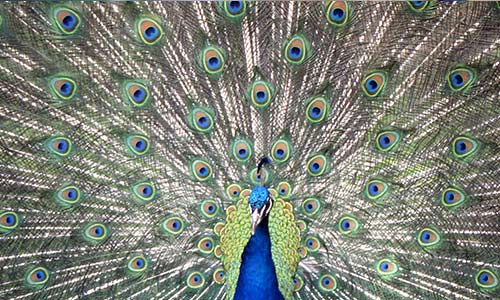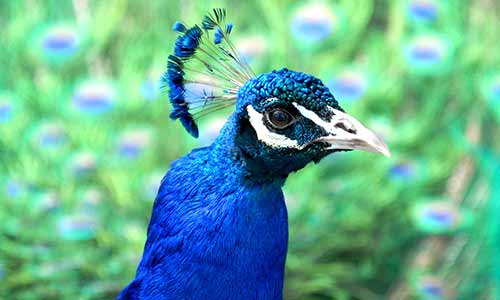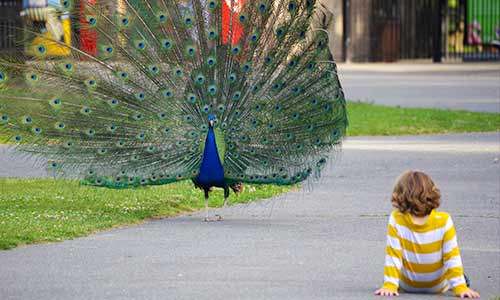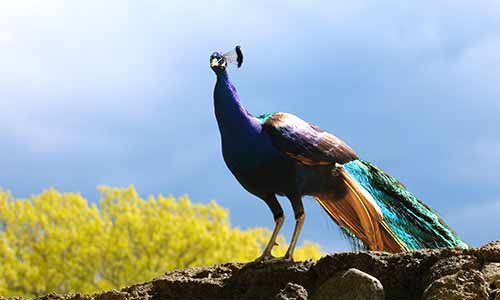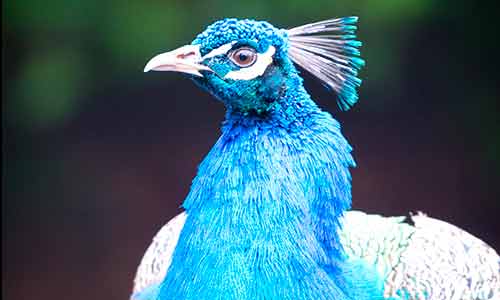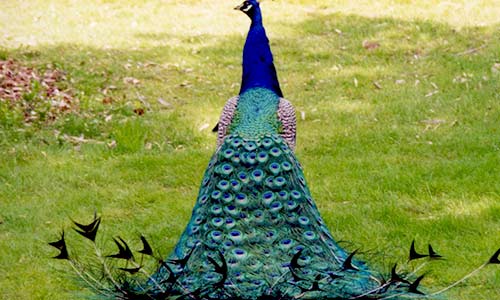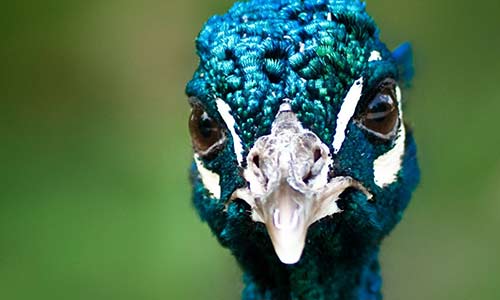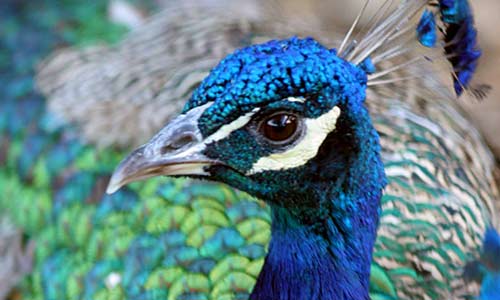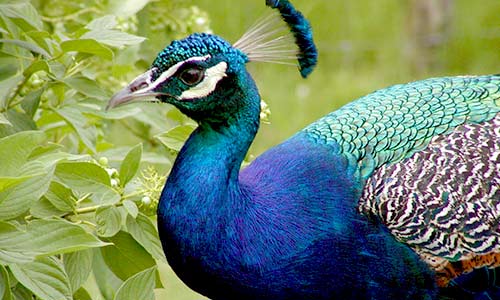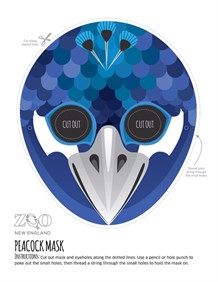Indian Blue Peafowl (Peacock)
Pavo cristatus
About the Indian Blue Peafowl (Peacock)

Geographic Range:

Class: Aves
Order: Galliformes
Family: Phasianidae
Genus: Pavo
Species: cristatus
Despite its large size, the Indian blue peafowl, better known as the peacock, is incredibly agile and will run or fly to escape predators. The male peafowl is a regal, shiny blue with patches of white above and below its eyes. A blue-tipped fan of feathers crowns its head and its long train of feathers trails behind like a royal cape. Males display their train feathers in a beautiful fan in order to attract a mate. The female peafowl has less dramatic coloring and plumage—it is predominantly white and brown with a metallic green upper breast, and its train is shorter and less ornate.
Peafowl Facts
Appearance:
The male peafowl has a shiny blue body, neck and head with patches of white below and above its eyes, and blue tipped feathers on top of its head. The back of its wings are grayish-brown, and white feathers spread from its bottom. Males have a train of feathers at their rear, which is almost two-thirds of their body in length. Peacock feathers have patterns resembling eyespots. The peacock’s train is not the same as its tail. The train is made of up quills which keep feathers straight, and the real peacock tail is brown. The female peafowl has a white face, throat, and belly, with a metallic green upper breast. Its back, head, and the back of its neck are brown. Females have the same train of feathers, but they’re much shorter and don’t have the same eyespots.
Size:
Peacocks are between 6 and 7.5 feet in length, and weigh between 6 and 13 pounds. Males are larger than females. Despite their large size, peacocks are very agile and can run or fly if they feel threatened.
Diet:
In the wild, peacocks feast on seeds, insects, fruits, small mammals and reptiles.
Reproduction:
The start of a new year marks the start of the peacock breeding season, which lasts from January to March. The courting process starts with the males forming breeding territories called “leks,” in which they display their brightly-colored train feathers to passing females. This fan-like display of feathers can also be used as a territorial defense. During courtship, males sing in loud tones of “ow-aaa, ow-aaa, ow-aaa!” to catch females’ attention. Females visit several leks, sometimes even making repeat visits, to select a mate. Selection is often dependent on the train feather size and number of eyespots.
After selection and mating, males leave, with no further involvement with the chicks or hen. Eggs (typically four to six) hatch between 28 and 30 days. The mother cares for her babies, called peachicks, for about 7 to 9 weeks. They’ll often climb on her back, and she’ll fly them to a safe tree branch. Peachicks reach maturity in approximately two to three years.
Behavior:
Peafowl have 11 different calls, often using calls as a warning to other animals that a predator is nearby. Territorial creatures, they often roost and feed in the same location. They defend themselves by shaking their fanned train feathers, pecking with their beaks and clawing with their talons. Although seemingly flightless, peacocks are actually excellent jumpers and flyers, and despite their large size, they’re incredibly agile.
Habitat/Range:
Native to India, Sri Lanka, Pakistan, Bhutan, Bangladesh and Nepal. Introduced populations may be seen in areas around Austrailia, New Zealand, Singapore, Bahamas and the USA. Captive specimens are found throughout the world. They prefer to live in open forests and in undergrowth near bodies of water. They can also be found in stream-side forests or open orchards.
Role in their habitats:
Peacocks are predators and prey, and while they seek out smaller animals and insects, they run from land cats, like leopards and tigers.
Median Life Expectancy:
Wild: about 15 years
Captive: between 15 and 20 years
Fun Facts:
- Most people call these birds peacocks, but that's the correct name for males; females are peahens, and males and females together are peafowl.
- There are three types of peafowl: Indian, green and Congo.
- The Indian peafowl is the national bird of India.
- Hindus consider this bird to be sacred because the eyes on its spots symbolize the eyes of the gods.
- A group of peafowl is called a "party" or "pride."
You Can Find This Animal in the Bird's World Exhibit
Kids' Corner
Make your own peacock mask in our Kids' Corner!
Did you Know?
Most people call these birds peacocks, which is the correct name for males. Females are peahens, and males and females together are peafowl.

